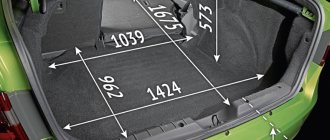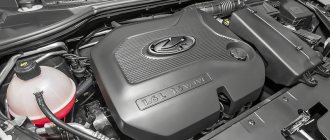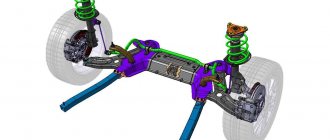In the fall, AVTOVAZ presented the updated Lada Vesta. Now this family is equipped with a Renault-Nissan alliance engine (1.6 l, 113 hp) and a continuously variable automatic transmission JF015E (hereinafter referred to as “variator” or CVT). We managed to find out how the car turned out during the test drive.
About the engine
Renault-Nissan HR16DE (1.6 l, 113 hp) is already familiar to us as H4M, because previously installed on Lada XRAY.
The main distinguishing features of this motor
:
- aluminum cylinder block;
- timing chain drive (no need to replace);
- automatic variable valve timing system, which improves filling of the engine cylinders in all operating modes;
- lack of hydraulic compensators (you will have to adjust the valves every 80 thousand km)
Specifications
:
- Maximum torque - 152Nm/4000rpm
- Maximum speed - 170 km/h
- Acceleration to 100 km/h - 12.2 seconds
- Fuel consumption in the combined cycle - 7.4 l/100km
The HR16DE/H4M engine is also installed on foreign cars: Nissan Note, Nissan Tiida, Nissan Qashqai, Nissan Sentra, Nissan Juke, etc. It has proven itself well among the owners of these cars and is an average engine.
Read more about this motor here.
Fuel consumption
The Vesta AT engine is designed for 95-grade gasoline, but you can also fill it with 92-grade gasoline, as evidenced by the sticker on the inside of the gas tank flap. Reviews of the Lada Vesta SV Cross with a CVT indicate that the passport fuel consumption data does not correspond to the real ones.
Manufacturers have set consumption in the city to 9.2 liters, on the highway 5.9 liters per 100 km. Reviews of the Vesta SV with a CVT indicate an underestimation of factory performance. During operation, the average values are 10-15% higher than the passport values. Fuel consumption depends on driving style, road congestion, and the condition of the road surface. It is noted that, on average, 95 gasoline is consumed less by 0.5 liters in the urban cycle.
About the variator
According to this site, the upgraded JF015E variator replaced the JF011E. The constructive idea is fundamentally different from its predecessor. The JF015E also has a torque converter that softens the load on the shafts, a planetary gear for reverse, but the main feature is two forward stages and three clutch packages: Direct No. 1 (Low), - No. 2 (High) and Reverse. This design made it possible to reduce the cone, increasing the gear ratio to a record 1:7.3 using two forward gears. Thus, this Jatco transmission can be called a two-speed CVT.
Box faults
Based on reviews from real owners of Vesta with a CVT, one can judge the reasons for the most frequent box failures.
Oil pump
The pump installed in the variator has a valve that becomes clogged. As a result, it may have poor oil flow and the pressure drops.
"Vesta" with a variator. Photo source: https://xn--80aal0a.xn--80asehdb/auto-news/lada-vesta-news/5183-kakie-obnovlenija-poluchila-lada-vesta-s-variatorom.html
While driving, the driver feels jerking as the speed increases.
Sun gear
This part is responsible in the planetary gear for the direction of movement of the car forward or backward. The gear is welded from two elements. The connecting seam cannot withstand heavy loads. As a result, when the handle is switched to the reverse position, the machine does not move.
Rumble in the box
Extraneous noise in the form of a hum is produced by cone bearings mounted on the variator shafts. These elements are subject to premature wear.
How Vesta drives with a CVT
During the test drive of the Lada Vesta with a CVT, the following features
:
- There is a creeping mode (in “D” mode, the car itself begins to move smoothly when the brake pedal is released).
- During acceleration, there is an imitation of gear shifting (during normal driving, shifting occurs at 3500 - 4000 rpm, at full throttle - after 5000 rpm).
- There is no monotonous howl of the engine during acceleration, which many owners of cars with a CVT do not like.
- “Shifting gears” occurs without the slightest jerk.
- In manual shift mode "M" there are 6 virtual gears.
- In manual mode, the virtual gear is automatically reset to 1st when stopped.
- In manual mode, the virtual gear will automatically shift at 5500 rpm (500-800 rpm higher than in "D" mode).
- Acceleration of the Lada Vesta SW Cross to 100 km/h with one passenger and a full trunk takes 16 seconds, without a passenger - 13.4 seconds (according to the passport 12.2 seconds).
- Acceleration of the Lada Vesta Cross sedan to 100 km/h was 12.7 seconds in one direction, 13.7 in the opposite direction (11.3 seconds according to the passport).
- Fuel consumption during fairly active mountain tests did not exceed 10.3 l/100km.
- The CVT settings keep the engine speed low, which allows the engine to be quieter than other transmissions (at 120 km/h your tachometer will read 2000 rpm).
- With a sharp start, a slight delay is felt before the start of movement.
- The engine braking capabilities of the car are very limited; there is no noticeable deceleration.
- Due to the appearance of new universal joints of the same length, now during acceleration, especially on poor surfaces, the steering wheel no longer breaks out of your hands, and there is more stability during emergency braking.
- Off the asphalt, the car feels very insecure (the car has difficulty crawling even on a grassy slope with a soft top layer, not to mention driving on a liquefied primer or slippery gravel).
- It is better to overcome steep climbs by walking. If you stop on such a hill, the variator sometimes rebels - when starting from a standstill, it releases the clutch and refuses to go further.
- The overtaking margin at speeds above 120 km/h is not enough, especially on mountain roads. On the plains the situation is better, but not globally. Even in manual mode it feels like you're driving in ECO mode.
In general, everything is simple, clear and practical. For the city, Vesta with a CVT is enough, but outside the asphalt the car feels very insecure. Have you ever driven a Lada Vesta with a CVT? What feedback and impressions can you leave?
Some features were taken from test drive data from wheels.ru and artemspec.
Pros and cons of Jatco JF015E
Replacing the AMT gearbox with a CVT was caused by numerous complaints about the operation of the transmission. Compared to robotic, CVT has a number of advantages:
- a creeping mode has appeared, in which the car starts moving without using the gas pedal;
- speed is gained without jerks or dips in traction;
- clear switching of forward and backward driving modes.
"Vesta" with CVT interior. Photo source: https://xn--80aal0a.xn--80asehdb/auto-news/lada-vesta-news/5183-kakie-obnovlenija-poluchila-lada-vesta-s-variatorom.html
Reviews from real owners of Lada Vesta with a CVT indicate that the car has become more economical. Fuel consumption in mixed mode has decreased compared to the robotic version of Vesta.
Due to the fact that it is installed on many brands of cars, the Jatco JF015E transmission has been well studied in service centers. The advantages of its repair and maintenance are noted:
- low cost and availability of spare parts;
- the ability to install elements that replace the original ones;
- Replacement units can be used from vehicles that are not suitable for use.
The manufacturer claims that the oil in the box is designed for the entire service life of the transmission. But reviews from owners of Lada Vesta with a CVT refute this statement. The oil needs to be changed, otherwise, after the warranty period expires, the gearbox will fail, which will result in significant financial costs for the owner.
Buttons on the driver's door. Photo source: https://xn--80aal0a.xn--80asehdb/auto-news/lada-vesta-news/5183-kakie-obnovlenija-poluchila-lada-vesta-s-variatorom.html
JF015E was developed for cars with an engine capacity of less than 1.8. Compared to its predecessor JF011E, the box has become less reliable. Transmission disadvantages:
- sensitivity to overloads, reducing service life;
- increased demands on the purity of transmission oil;
- failure of individual transmission components.
Despite the assurances of AvtoVAZ, maintenance services recommend checking the quality of transmission oil at every scheduled technical inspection. When the mileage reaches 60 thousand, perform an incomplete replacement of the transmission fluid even if its condition is satisfactory.
Prices
The version with a CVT will be 50 thousand more expensive than the version with a VAZ-21179 engine and manual transmission. With the launch of the CVT version, all trim levels have been updated:
- The most affordable version is the 1.6 sedan (113 hp), AT Jatco, Classic + Start Plus - 736,900 rubles.
- The maximum cost for Lada Vesta SW Cross 1.6 (113 hp), AT Jatco, Luxe + Prestige is 982,900 rubles.
Service life of the power unit and transmission
The engine has the full name HR16DE-H4M. The power unit is reliable and economical. AvtoVAZ adapted the engine for installation on Vesta. The plant does not indicate the service life, but, according to car enthusiasts, with timely, high-quality maintenance, the service life is at least 250 thousand km.
"Vesta" with CVT, engine. Photo source: https://xn--80aal0a.xn--80asehdb/auto-news/lada-vesta-news/5183-kakie-obnovlenija-poluchila-lada-vesta-s-variatorom.html
The service life of the JF015E transmission depends on driving style and timely maintenance. The box is sensitive to overloads, so it is recommended to avoid sudden starts, slipping and sudden braking. According to the owners of cars with such a transmission, its service life can reach 100 thousand km. AvtoVAZ has set the service life of the variator to 120 thousand km or 8 years of operation.
City trips
The new transmission made the car more comfortable in urban environments. The CVT Lada Vesta starts moving smoothly; in street congestion and traffic jams you don’t have to use the gas pedal, the car drives in a crawling mode. The dynamics of the new 113-horsepower engine are enough for acceleration and lane changes.
If you compare the Vesta AT-CVT with the AMT version, you can feel that the noise in the cabin has decreased and the vibration has become less noticeable. Owners and experts agree that Vesta is a car for the city.
Lada Vesta will get new options and engine
The Lada Izhevsk plant began producing the richest versions of Vesta with long-promised side airbags and climate control. According to Autoreview, such sedans will go on sale at the end of May, but they will be produced in small quantities. And after them Vesta should enter the market with a more powerful engine!
Climate control unit...
...and a regular air conditioner in Vesta differ only in the purpose of the keys and the functionality of the display
0 / 0
So far, Lada Vesta sedans are sold only with VAZ 1.6 engines with 106 hp. But last fall, as part of the first comparative test, we were able to drive a prototype with a Nissan HR16 engine (1.6 liters, 114 hp), which is assembled at AvtoVAZ and installed on Russian cars Lada XRAY, Renault Duster, Nissan Sentra and Qashqai . Then we did not notice a serious difference in dynamics and comfort between Vestas with two engines: a sedan with a Nissan unit reaches “hundreds” only 0.7 seconds faster than a car with a VAZ engine (11.7 versus 12.4 s), and the maximum speed has only increased by 3.9 km/h, up to 177.9 km/h.
Our conclusion was unequivocal: the expensive versions of Vesta would be much better suited to the new VAZ 1.8 engine (VAZ-21179) with a phase shifter (122 hp). And it seems that AvtoVAZ listened to our wishes! According to Autoreview, the Lada Vesta 1.8 will hit the market in July or August - however, only with an AMT robotic gearbox. However, in the future it is possible that a version with “mechanics” will appear.
Engine VAZ-21179
As for the modification with a Nissan engine, as far as we know, Tolyatti is not yet planning to abandon it, but the start of production has been postponed indefinitely. The higher price of the Japanese engine compared to the Russian one almost certainly played a role: it will not be easy to recoup it while maintaining competitive selling prices for cars.
Now the most expensive Vesta costs 707 thousand rubles (Luxury package with Multimedia package, “robot”, Lime body color), and with the advent of new options, the maximum price will increase to approximately 750 thousand. And the 1.8 engine will add 40 thousand to the price, although powerful sedans should also be available in “medium” trim levels.
Meanwhile, Vesta sales are gradually growing: 1,643 cars were sold in January, 2,955 in February, 4,595 in March, and the April result is already 4,821 cars. Based on the results of four months, the model ranks sixth in the sales ranking of new cars (14,014 units), ahead of Hyundai Solaris (29,627), Lada Granta (28,781), Kia Rio (23,256), Renault Duster (15,266) and Volkswagen Polo (14,214).











